Taxonomy of the Orchidaceae
The taxonomy of the Orchidaceae (orchid family) has evolved slowly during the last 250 years, starting with Carolus Linnaeus who in 1753 recognized eight genera. De Jussieu recognized the Orchidaceae as a separate family in 1789. Olof Swartz recognized 25 genera in 1800. Louis Claude Richard provided us in 1817 with the descriptive terminology of the orchids. The next step was taken in 1830-1840 by John Lindley, who recognised four subfamilies. He is generally recognized as the father of orchid taxonomy. The next important step was taken by George Bentham in 1881 with a new classification, recognizing subtribes for the first time. The next great contributors were Pfitzer (1887), Schlechter (1926), Mansfeld (1937), Dressler and Dodson (1960), Garay (1960, 1972), Vermeulen (1966), again Dressler (1981) and Burns-Balogh and Funk (1986). The latest contribution, Genera Orchidacearum (Pridgeon, A.M., Cribb, P.J., Chase, M.A. & Rasmussen, F. (1999-2009), Oxford: Oxford Univ. Press.) has published Volumes 1-5 with Volume 6 to follow. It is now more accepted to use this re-circumscription, which follows on from Dressler, but with modifications provided by phylogeny. Changes in the taxonomy of orchids are so frequent that it is also recommended that the regularly updated World Checklist of Selected Plant Families is consulted for the most current generic and species classifications. Wikispecies (Orchidaceae) closely follows these two sources with modifications as they become accepted.
History
The following taxonomy follows largely the classification system of Robert Louis Dressler, an orchid specialist and adjunct curator at the Florida Museum of Natural History. This classification, published in the book The Orchids: Natural History and Classification, is widely accepted by botanists and growers. The initial scheme of 1981 has been modified in 1986, twice in 1990. and then again in 1993. This comprehensive classification relies heavily on morphology and a few key characters, such as anther configuration and pollinarium structure and therefore many of the taxa are not monophyletic.
According to morphological cladistics and research with rbcL nucleotide sequences, the orchid family, as well as the clades within the family, are a monophyletic group. There is a great similarity with the traditional taxonomy, except for the Vandoideae, but on lower levels, some matters are still unresolved. Tribes and sub-tribes, as listed here below, are increasingly becoming monophyletic, as circumscriptions are resolved, but this has resulted in reassignment of taxa. Cladistic and molecular methods give us a firmer basis, but orchid classification is still an ongoing issue, for example, support for the interelationships of the subfamilies is only just emerging. Furthermore, about 150 species and even new genera are still being regularly discovered annually.
New developments in this taxonomy occur regularly:
- 1998: Publication of "A phylogenetic analysis of the Orchidaceae: evidence from rbcL nucleotide sequences" by Kenneth M. Cameron in the American Journal of Botany. 1999. In this study, he supports the five primary monophyletic clades (indicated as subfamilies by Dressler) and states that there is no evidence supporting the previously recognized subfamilies Spiranthoideae, Neottioideae, or Vandoideae.[1]
- 2003: the Angiosperm Phylogeny Group publishes its update of the classification for the orders and families of flowering plants. In this APG III-system, the family Orchidaceae is included in the order Asparagales.[2]
- 2005: Publication by Chase et al. of a new phylogenetic classification based on recent DNA research [3]
Taxonomy
The orchid family (Orchidaceae) is subdivided into five subfamilies, and then into tribes, subtribes, alliances (not a classification used in the International Code of Nomenclature for algae, fungi, and plants) and then genera through sub-genera down to the species. Contemporary taxonomy allows for the accepted nomenclature of natural hybrids.
According to Dressler, there are 5 subfamilies, 22 tribes, 70 subtribes, about 850 genera and about 20,000 species in this family.
A distinction between monandrous and other flowers is particularly relevant in the classification of orchids. The monandrous orchids form a clade consisting of the subfamilies Orchidoideae, Vanilloideae, and Epidendroideae. The other subfamilies, Apostasioideae and Cypripedioideae, have at least two stamens.
The following subfamilies are recognized:
- Subfamily Apostasioideae: monophyletic - the most basal of the orchids: 3 fertile anthers or two fertile anthers and a filamentous staminode.
- Subfamily Cypripedioideae: monophyletic - 2 fertile diandrous anthers, a shield-shaped staminode and a saccate (= pouch-like) lip.
- Subfamily Orchidoideae: single, fertile monandrous, basitonic anther.
- (Subfamily Spiranthoideae): now accepted as nested within a more broadly defined Orchidoideae as the sub-tribe Spiranthinae
- Subfamily Epidendroideae: includes almost 80% of the orchid species; monophyletic; orchids with an incumbent to suberect ( = ascending towards the edges) anther.
- (Subfamily Higher Epidendroideae (formerly Vandoideae): specialised clade within a more broadly defined Epidendroideae
- Subfamily Vanilloideae: an ancient clade now recognized as a distinct subfamily. But, from a molecular point of view, it is rather a sister to subfamily Epidendroideae + subfamily Orchidoideae. This subfamily is a branch at the basal dichotomy of the monandrous orchids.
Cladistically the interrelationships of these subfamilies can be shown as follows:
| Asparagales |
| |||||||||||||||||||||||||||||||||
| |
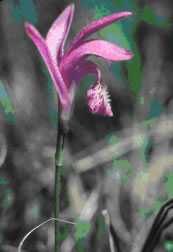
Subfamily Apostasioideae
The subfamily Apostasioideae belongs to the orchid family (Orchidaceae). It is a clade, but there is bootstrap support that it is a sister to the other orchid subfamilies. A bootstrap is a method for evaluating the statistical importance of positions of different branches in a phylogenetic tree (= a treelike structure giving the evolutionary development of organisms).
The apostasioid orchids are the most primitive orchids, with only two genera. Neuwiedia has 3 fertile, abaxial (= facing away from the stem) anthers, while Apostasia has two fertile abaxial anthers and a filamentous staminode (= a sterile stamen). Plants with mealy or paste-like pollen, which ordinarily are not aggregated into pellets, called pollinia, with two or three fertile long anthers, leaves with stealthing bases, elongated staminodium and labellum similar to the petals.
These primitive features make them, according to some authorities, not true orchids but rather ancestors of modern orchids. However, modern studies (Stern, Cheadle and Thorsch, 1993) point out that the apostasioid orchids are uniquely defined ( = autapomorphous). This makes them unsuitable as models to be the ancestors of the orchids.
Subfamily Cypripedioideae
6 genera with about 115 species, mostly terrestrials or lithophytes:
Tribe Cypripedieae
Subtribe Cypripediinae
- Cypripedium Lindl., included Arietinum Beck, Calceolaria Heist. ex Fabr., Calceolus Nieuwl., Ciripedium Zumagl., Criogenes Salisb., Fissipes Small, Hypodema Rchb., Sacodon Raf., Schizopedium Salisb., Stimegas Raf.
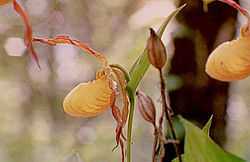
Subtribe Paphiopedilinae
- Paphiopedilum Pfitzer, included Cordula Raf. and Menephora Raf.
Tribe Mexipedieae
Subtribe Mexipediinae
- Mexipedium V.A.Albert & M.W.Chase
Tribe Phragmipedieae
Subtribe Phragmipediinae
- Phragmipedium Rolfe, included Phragmopedilum Pfitzer, Uropedium Lindl.
Tribe Selenipedieae
Subtribe Selenipediinae
Others
- xPhragmipaphium Hort.
Subfamily Epidendroideae
This is the largest subfamily, having the largest proportion of incest, comprising more than 10,000 species in about 90 to 100 genera. Most are tropical epiphytes (usually with pseudobulbs), but some are terrestrials and even a few myco-heterotrophs. All show a unique development of the single anther: it is incumbent forming a right angle with the column axis or pointed backward in many genera. Most have hard pollinia, i.e. a mass of waxy pollen or of coherent pollen grains; pollinia with caudicle and viscidium or without; stigma entire or 3-lobed; rostellum present; 1-locular ovary; leaves: distichous or spiraling
Tribe Arethuseae
Over 500 species.
Subtribe Arethusinae
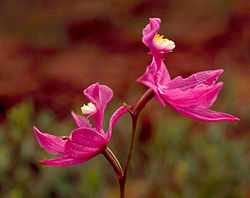
- Arethusa L.
- x Elearethusa
- x Elecalthusa
- Eleorchis F.Maek.
- x Elepogon
Subtribe Bletiinae
- Ancistrochilus Rolfe
- Anthogonium Wall. ex Lindl.
- Cephalantheropsis Guillaumin
- Eriodes Rolfe, included Neotainiopsis Bennet & Raizada, Tainiopsis Schltr.
- Hancockia Rolfe
- Hexalectris Raf.
- Ipsea Lindl.
- Mischobulbum Schltr., included Mischobulbon Schltr. (orth. var.)
- Nephelaphyllum Blume
- Pachystoma Blume, included Apaturia Lindl., Pachychilus Blume and Pachystylis Blume
- Alliance Arundina
- Arundina Rich.
- Alliance Calopogon
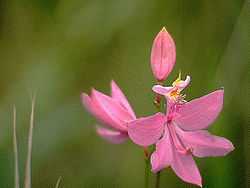
- Alliance Calanthe
- Acanthephippium Blume, included Acanthophippium Blume (orth. var.)
- Bletia Ruiz & Pav., included Anthogyas Raf., Bletiana Raf., Crybe Lindl., Gyas Salisb., Regnellia Barb. Rodr., Thiebautia Colla
- Bletilla Rchb.f., included Jimensia Raf., Polytoma Lour. ex Gomes
- Calanthe R.Br., included Alismorkis Thouars, Amblyglottis Blume, Aulostylis Schltr., Calanthidum Pfitzer, Centrosia A.Rich., Centrosis Thouars, Cytheris Lindl., Ghiesbreghtia A.Rich. & Galeotti, Limatodes Blume, Paracalanthe Kudô, Preptanthe Rchb.f., Styloglossum Breda, Sylvalismis Thouars
- Phaius Lour., included Cyanorchis Thouars, Gastorchis Thouars, Gastrorchis Schltr., Hecabe Raf., Pachyne Salisb., Pesomeria Lindl., Tankervillia Link
- Spathoglottis Blume, included Paxtonia Lindl.
- Alliance Coelia
- Alliance Chysis
- Alliance Plocoglottis
- Alliance Tainia
Subtribe Sobraliinae
Subtribe Thuniinae
Tribe Calypsoeae
Tribe Cryptarrheneae
- Cryptarrhena R.Br., included Orchidofunckia A.Rich. & Galeotti
Tribe Coelogyneae
Over 400 species
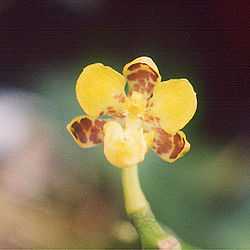
Subtribe Adrorhizinae
- Adrorhizon Hook.f.
Subtribe Coelogyninae
Tribe Epidendreae
Cosmopolitan; largest tribe of this subfamily, with over 8,000 species
Subtribe Glomerinae
Subtribe Laeliinae: over 1400 species, mostly tropical American epiphytes, in 43 genera. It contains more than 25% (136) of all hybrid genera.
- Alliance Isochilus
- Alliance Cattleya
- Brassavola R.Br., included Eudisanthema Neck. ex Post & Kuntze, Lysimnia Raf., Tulexis Raf.
- Broughtonia R.Br., included Cattleyopsis Lem., Laeliopsis Lindl. & Paxton
- Cattleya Lindl., included Maelenia Dumort.
- Encyclia Hook., included Amblostoma Scheidw., Dinema Lindl., Hormidium (Lindl.) Heynh., Sulpitia Raf.
- Laelia Lindl., included Amalia Rchb.
- Myrmecophila Rolfe
- Rhyncholaelia Schltr.
- Schomburgkia Lindl.
- Sophronitis Lindl., included Lophoglottis Raf., Sophronia Lindl.
- Guarianthe Dressler & W.E. Higgins (2003)
- Alliance Barkeria
- Barkeria Knowles & Westc.
- Caularthron Raf., included Diacrium (Lindl.) Benth.
- Alliance Epidendrum
- Epidendrum Jacq., included Amphiglottis Salisb., Anacheilium Hoffmanns., Anocheil' Hoffmanns. ex Rchb., Auliza Small, Coilostylis Raf., Didothion Raf.,, Diothonea Lindl., Dothilophis Raf., Doxosma Raf., Epicladium Small, Epidanthus L.O.Williams, Epidendropsis Garay & Dunst., Exophya Raf., Hemiscleria Lindl., Kalopternix Garay & Dunst., Lanium (Lindl.) Benth., Larnandra Raf., Microepidendrum Brieger (nom. inval.), Minicolumna Brieger (nom. inval.), Nanodes Lindl., Neolehmannia Kraenzl., Neowilliamsia Garay, Nyctosma Raf., Phadrosanthus Neck. ex Raf., Physinga Lindl., Pleuranthium Benth., Prosthechea Knowles & Westc., Pseudepidendrum Rchb.f., Seraphyta Fisch. & C.A.Mey., Spathiger Small, Stenoglossum Kunth, Tritelandra Raf.
- Alliance Leptotes
- Alliance Neocogniauxia
- Neocogniauxia Schltr.
- Dilomilis Raf.
- Tomzanonia Nir
- Alliance hybrids
- Brassocattleya hort.
- Brassoepidendrum hort.
- Brassolaeliocattleya hort.
- Cattleytonia hort.
- Epicattleya hort.
- Epilaeliocattleya hort.
- Hawkinsara hort.
- Laeliocatonia hort.
- Laeliocattleya hort. ex Rolfe
- Otaara hort.
- Potinara hort.
- Schombocattleya hort.
- Sophrocattleya hort.
- Sophrolaelia hort.
- Sophrolaeliocattleya hort.
Subtribe Meiracyllinae
- Subtribe Pleurothallidinae
These species have single leaves, non-pseudobulbous ramicauls, articulated ovary, deciduous from the pedicel.
- Genera: Acianthera, Acostaea, Anathallis, Barbosella, Barbrodria, Brachionidium, Chamelophyton, Condylago, Draconanthes, Dracula, Dresslerella, Dryadella, Echinosepala, Frondaria, Jostia, Lepanthes, Lepanthopsis, Luerella, Masdevallia, Myoxanthus, Octomeria, Ophidion, Pabstiella, Phloeophila, Platystele, Pleurothallis, Porroglossum, Restrepia, Restrepiella, Salpistele, Scaphosepalum, Specklinia, Stelis, Teagueia, Trichosalpinx, Trisetella, Zootrophion
Tribe Epipogieae
- Genera: Epipogium, Stereosandra
Tribe Gastrodieae
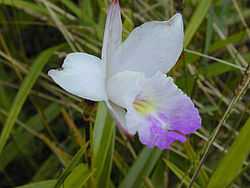
- Subtribe Gastrodiinae
- Genera: Didymoplexis, Gastrodia
- Subtribe Nervilliinae
- Genus: Nervilia
- Subtribe Rhizanthellinae (sometimes in Diurideae)
- Genera: Cryptanthemis, Rhizanthella
Tribe Malaxideae
Over 900 species
Tribe Neottieae
About 100 species
- Subtribe Limodorinae
- Genera: Aphyllorchis, Cephalanthera, Epipactis, Limodorum
- Subtribe Listerinae
- Genus: Listera
Tribe Podochileae
- Subtribe Bulbophyllinae (according to Garay & al. 1994)
- Genus: Acrochaene Lindl., Bulbophyllum Thouars, Chaseella Summerhays, Cirrhopetalum Lindl., Codonosiphon Schl., Drymoda Lindl., Epicrianthes Blume, Ferruminaria Garay, Hamer & Siegerist, Hapalochilus (Schlechter) Senghas, Ione Lindl., Mastigion Garay, Hamer & Siegerist , Monomeria Lindl., Monosepalum Schle, Osyricera Blume, Pedilochilus Schl., Rhytionanthos Garay, Hamer & Siegerist, Saccoglossum Schl., Sunipia Lindl., Synarmosepalum Garay, Hamer & Siegerist, Tapeinoglossum Schl., Trias Lindl., Vesicisepalum Garay, Hamer & Siegerist
- Subtribe Dendrobiinae
- Genera: Cadetia, Dendrobium, Diplocaulobium, Epigeneium, Flickingeria, Pseuderia
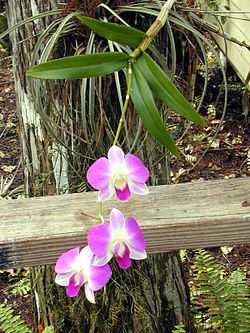
- Subtribe Eriinae
- Alliance Eria
- Genera: Eria, Trichotosia
- Alliance Ceratostylis
- Genera: Appendicula, Ceratostylis, Epiblastus, Sarcostoma
- Alliance Eria
- Subtribe Podochilinae
- Genera: Chilopogon, Podochilus
- Subtribe Thelasiinae
- Genera: Phreatia, Rhynchophreatia
Tribe Tropidieae
Formerly placed in the subfamily Spiranthoideae
- Genera: Corymborkis, Tropidia
Tribe Xerorchideae
- Genus: Xerorchis
Subfamily Higher Epidendroideae
Formerly called Vandoideae, this is the second largest subfamily with over 300 genera in more than 5,000 species. They are mostly epiphytes, but include some terrestrials and myco-heterotrophs, all occurring in most tropical areas. The main stem grows in a single direction. Many of the species develop pseudobulbs (i.e. a bulge at the base of a stem), that are normally shorter and sturdier than those in the epidendroids. The striking characteristics of the vandoids are a cellular pollinium stalk (= stipe), superposed pollinia and the unique development of the incumbent anther, that bends early in development.
Tribe Cymbidieae
About 1,800 species in 100 to 130 genera. Species are either terrestrial or epiphytic, and range throughout global tropical regions. All species have, as a unique feature, a sympodial growth habit and two pollinia.
- Subtribe Acriopsidinae: less than 50 species.
- Genus: Acriopsis
- Subtribe Catasetinae: about 150 species; epiphytes occurring in the Western Hemisphere.
- Subtribe Cyrtopodiinae: over 400 species, usually terrestrial; Asia, Africa, and tropical America.
- Alliance Bromheadia
- Genus: Bromheadia
- Alliance Eulophia
- Genus: Eulophia
- Alliance Cyrtopodium
- Genera: Cymbidiella, Cyrtopodium, Galeandra
- Alliance Cymbidium
- Genera: Ansellia, Cymbidium, Grammatophyllum
- Alliance Dipodium
- Genus: Dipodium
- Alliance hybrids
- Genera: Bifrenidium, Cymphiella, Cyrtellia, Eulocymbidiella, Galeansellia, Graphiella
- Alliance Bromheadia
- Subtribe Oncidiinae: Largest subtribe with nearly 1,000 species within about 56 to 78 genera, found in tropical America, the Caribbean and Florida. Most are epiphytes, but a few are terrestrials..They usually have short and stout pseudobulbs.
- Alliance Oncidium: largest alliance; includes the majority of genera in cultivation.
- Genera: Ada, Aspasia, Brassia, Cochlioda, Miltonia, Miltoniopsis, Odontoglossum, Oncidium (most)
- Alliance Trichocentrum
- Genus: Trichocentrum
- Alliance Comparettia
- Genera: Oncidium (equitants only), Comparettia, Rodriguezia
- Alliance Trichophilia
- Genera: Notylia, Psychopsis, Trichopilia
- Alliance Lockhartia
- Genus: Lockhartia
- Alliance hybrids: over 107 hybrid genera.
- Genera: Aliceara, Bakerara, Beallara, Brassidium, Burrageara, Colmanara, Degarmoara, Howeara, Maclellanara, Miltassia, Miltonidium, Odontobrassia, Odontocidium, Odontonia, Rodricidium, Trichocidium, Vuylstekeara, Wilsonara
- Alliance Oncidium: largest alliance; includes the majority of genera in cultivation.
- Subtribe Pachyphyllinae: less than 50 species.
- Genus: Pachyphyllum
- Subtribe Thecostelinae: less than 50 species.
- Genus: Thecostele
Tribe Vandeae
Over 1,700 species in more than 130 genera; occurs in tropical Asia, Pacific Islands, tropical America, Australia, and Africa.
- Subtribe Aerangidinae: about 300 species in 36 genera; tropical Africa and Madagascar.
- Genera: Aerangis, Ancistrorhynchus, Angraecopsis, Beclardia, Bolusiella, Chamaeangis, Cribbia, Cyrtorchis, Diaphananthe, Eurychone, Listrostachys, Microcoelia, Microterangis, Mystacidium, Podangis, Rangaeris, Rhipidoglossum, Solenangis, Sphyrarhynchus, Tridactyle, Ypsilopus
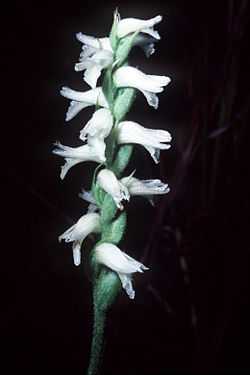
- Subtribe Aeridinae (formerly Sarcanthinae): more than 1,000 species in 103 genera, including about 200 hybrid species; occurs mostly in Asia with a few in Africa.
- Alliance Phalaenopsis
- Genera: Aerides, Chiloschista, Doritis, Phalaenopsis, Paraphalaenopsis, Rhynchostylis, Sarcochilus
- Alliance Vanda
- Genera: Adenoncos, Arachnis, Ascocentrum, Ascoglossum, Euanthe, Luisia, Renanthera, Vanda, Vandopsis
- Alliance Trichoglottis
- Genera: Abdominea, Acampe, Amesiella, Cleisostoma, Gastrochilus, Neofinetia, Robiquetia, Trichoglottis
- Hybrids
- Alliance Phalaenopsis
- Subtribe Angraecinae: about 400 species in 19 genera, tropical Africa and Madagascar.
- Alliance Angraecum
- Genera: Aeranthes, Angraecum, Bonniera, Calyptrochilum, Cryptopus, Jumellea, Lemurella, Lemurorchis, Neobathiea, Oeonia, Oeoniella, Sobennikoffia
- Alliance Campylocentrum
- Genera: Campylocentrum, Dendrophylax
- Alliance Angraecum
- Subtribe Polystachyinae (formerly part of the Epidendreae): about 220 species in four genera: Hederorkis,Imerinaea,.Neobenthamia and Polystachya They all show four pollinia. The lip often has mealy hairs called pseudopollen on the upper surface.
Tribe Maxillarieae
70 to 80 genera with about 1,000 species; most grow in tropical America as terrestrials or epiphytes, a few are myco-heterotrophs. Most show pseudobulbs, but a few have reedlike stems or thick underground stems. Blooms have four pollinia.
- Subtribe Bifrenariinae: thin and pleated leaves.
- Genera: Bifrenaria, Xylobium
- Subtribe Corallorhizinae: all myco-heterotrophs
- Genera: Aplectrum, Corallorrhiza
- Subtribe Dichaeinae
- Genus: Dichaea
- Subtribe Lycastinae: thin and pleated leaves.
- Genera: Anguloa, Bifrenaria, Lycaste, Neomoorea, /small>, Ciripedium Rudolfiella, Teuscheria, Xylobium
- Subtribe Maxillariinae: largest subtribe with nearly half of the tribe species. The leathery leaves are conduplicate, i.e. folded together lengthwise.
- Genera: Chrysocycnis, Cyrtidium, Maxillaria, Mormolyca, Pityphyllum, Scuticaria, Sepalosaccus, Trigonidium
- Subtribe: Ornithocephalinae
- Genera: Ornithocephalus, Zygostates
- Subtribe Stanhopeinae: about 200 species; epiphytes found in the Western Hemisphere.
- Genera: Acineta, Braemia, Cirrhaea, Coryanthes, Embreea, Gongora, Horichia, Houlletia, Jennyella, Kegeliella, Lacaena, Lueddemannia, Paphinia, Polycycnis, Schlimia, Sievekingia, Soterosanthus, Stanhopea, Trevoria, Vasqueziella
- Subtribe Coeliopsidinae
- Genera: Coeliopsis, Lycomormium, Peristeria
- Subtribe Telipogoninae
- Genera: Dipterostele, Hofmeisterella, Stellilabium, Telipogon, Trichoceros
- Subtribe Zygopetilinae: about 150 species. Most exhibited hybrids are to be found in this subtribe.
- Alliance Warrea
- Alliance Zygopetalum
- Genera: Aganisia, Batemannia, Bollea, Cheiradenia, Chondrorhyncha, Cochleanthes, Colax, Pabstia, Promenaea, Zygopetalum
- Alliance Bollea
- Genera: Bollea, Chondrorhyncha, Cochleanthes, Huntleya, Kefersteinia, Pescatoria, Stenia
- Alliance Vargasiella
- Genus: Vargasiella
- Alliance hybrids: of the 43 hybrids in this tribe, only Angulocaste is displayed frequently.
- Genera: Aitkenara, Bateostylis, Bollopetalum, Chondrobollea, Cochella, Cochlecaste, Cochlenia, Cochlepetalum, Downsara, Durutyara, Hamelwellsara, Huntleanthes, Kanzerara, Keferanthes, Lancebirkara, Otocolax, Otonisia, Palmerara, Rotorara, Zygocaste, Zygolum, Zygonisia, Zygostylis
Subfamily Orchidoideae
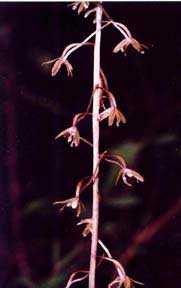
Tribe Diceratosteleae
- Genus: Diceratostele
Tribe Codonorchideae
- Genus: Codonorchis
Tribe Cranichideae
The former subfamily Spiranthoideae is now embedded in the clade Orchidoideae as the tribe Cranichideae (Dressler, 1993). It includes 95 genera and about 1100 species. Species of this polyphyletic tribe occur in all continents (except Antarctica), but mainly in North and South America and tropical Asia. All subtribes are monophyletic.
- Subtribe Cranichidinae: occurring in the Neotropics
- Genera: Altensteinia, Baskervilla, Cranichis, Exalaria, Fuertesiella, Myrosmodes, Nothostele, Ponthieva, Pseudocentrum, Pseudocranichis, Pterichis, Solenocentrum
- Subtribe Prescottiinae: occurs in the Neotropics
- Genera: Aa, Gomphichis, Porphyrostachys, Prescottia, Stenoptera
- Subtribe Galeottiellinae
- Genus: Galeottiella
- Subtribe Goodyerinae: 37 genera, about 630 species in Africa, the Americas and Asia.
- Genera: Aenhenrya, Anoectochilus, Aspidogyne, Chamaegastrodia, Cheirostylis, Cystorchis, Danhatchia, Dassinia, Erythrodes, Eurycentrum, Gonatostylis, Goodyera, Halleorchis, Herpysma, Hetaeria, Hylophila, Kreodanthus, Kuhlhasseltia, Lepidogyne, Lageophila, Ludisia, Macodes, Meliorchis (extinct), Microchilus, Myrmechis, Odontochilus, Orchipedum, Papuaea, Platylepis, Platythelys, Rhamphorhynchus, Rhomboda, Stephanothelys, Vrydagzynea, Zeuxine
- Subtribe Manniellinae: tropical Africa
- Genus: Manniella
- Subtribe Pterostylidinae
- Genus: Pterostylis
- Subtribe Spiranthinae: about 30 genera; largely terrestrial; widespread, but absent in sub-Saharan Africa; fascicled roots, dorsal erect anther, inconspicuous staminodia, resupinate flowers.
- Genera: Aracamunia, Aulosepalum, Beloglottis, Brachystele, Buchtienia, Coccineorchis, Cotylolabium, Cybebus, Degranvillea, Deiregyne, Dichromanthus, Discyphus, Eltroplectris, Eurystyles, Funkiella, Hapalorchis, Helonoma, Kionophyton, Lankesterella, Lyroglossa, Mesadenella, Mesadenus, Microthelys, Odontorrhynchus, Pelexia, Physogyne, Pseudogoodyera, Pteroglossa, Sacoila, Sarcoglottis, Sauroglossum, Schiedeella, Skeptrostachys, Spiranthes, Stalkya, Svenkoeltzia, Thelyschista, Veyretia, Wallnoeferia
- Subtribe Stenorrhynchidinae
- Genera: Stenorrhynchos
- Subtribe Cyclopogoninae
- Genera: Cyclopogon
- Subtribe Pachyplectroninae: endemic to New Caledonia
- Genera: Pachyplectron
Tribe Diseae
- Subtribe Brownleeinae
- Genus: Brownleea
- Subtribe Coryciinae
- Genera: Ceratandra, Corycium, Disperis, Evotella, Pterygodium
- Subtribe Disinae
- Genera: Disa, Schizodium
- Subtribe Huttonaeinae
- Genus: Huttonaea
- Subtribe Satyriinae
- Genera: Pachites, Satyrium
Tribe Diurideae
About 550 species in 39 genera; mainly Australasia.
- Subtribe Acianthinae
- Genera: Acianthus, Corybas, Cyrtostylis, Stigmatodactylus, Townsonia
- Subtribe Caladeniinae
- Subtribe Chloraeinae: From South America and New Caledonia (Megastylis)
- Genera: Bipinnula, Chloraea, Gavilea, Geoblasta, Megastylis
- Subtribe Cryptostylidinae
- Genera: Coilochilus, Cryptostylis
- Subtribe Diuridinae
- Genera: Diuris, Orthoceras
- Subtribe Drakaeinae
- Genera: Arthrochilus, Calaena, Chiloglottis, Drakaea, Myrmechila, Spiculaea
- Subtribe Megastylidinae
- Genera: Burnettia, Leporella, Lyperanthus, Megastylis, Pyrorchis, Rimacola, Waireia
- Subtribe Prasophyllinae
- Genera: Genoplesium, Microtis, Prasophyllum
- Subtribe Pterostylidinae
- Subtribe Thelymitrinae
- Genera: Calochilus, Epiblema, Thelymitra
Tribe Orchideae
This is the largest tribe, containing more than 1,700 species.
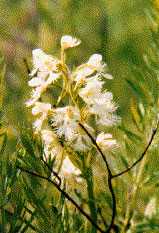
- Subtribe Orchidinae
- Genera: Aceratorchis, Amerorchis, Amitostigma, Anacamptis, Androcorys, Bartholina, Benthamia, Bonatea, Brachycorythis, Centrostigma, Chamorchis, Chondradenia, Cynorchis, Dactylorhiza, Diphylax, Diplomeris, Dracomonticola, Galearis, Gennaria, Gymnadenia, Habenaria, Hemipilia, Herminium, Himantoglossum, Holothrix, Megalorchis, Neobolusia, Neotinea, Neottianthe, Oligophyton, Ophrys, Orchis, Pecteilis, Peristylus, Physoceras, Platanthera, Platycoryne, Ponerorchis, Porolabium, Pseudorchis, Roeperocharis, Schizochilus, Serapias, Smithorchis, Stenoglottis, Steveniella, Symphyosepalum, Thulinia, Traunsteinera, Tylostigma, Veyretella
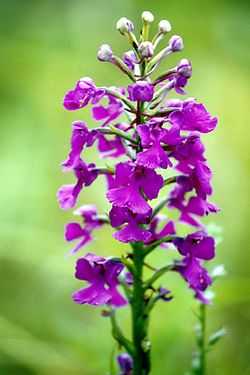
(Platanthera peramoena)
Subfamily Vanilloideae
Tribe Pogonieae
- Genera: Cleistes, Duckeella, Isotria, Pogonia, Pogoniopsis
Tribe Vanilleae
- Genera: Clematepistephium, Cyrtosia, Dictyophyllaria, Epistephium, Eriaxis, Erythrorchis, Galeola, Lecanorchis, Pseudovanilla, Vanilla
Not assigned
These two tribes have recently been assigned to a specific subfamily:
Tribe Triphoreae: A primitive tribe consisting of three genera and twenty species has been assigned to Epidendroideae.
- Genera: Monophyllorchis, Triphora
Tribe Wullschlaegelieae:only one genus with two species. The tribe has been lost and the genus has now been assigned to sub-family Epidendroideae, tribe Calypsoeae.
- Genus: Wullschlaegelia
References
- ↑ K.M. Cameron, M.W. Chase, W.M. Whitten, P.J. Kores, D.C. Jarrell, V.A. Albert, T. Yukawa, H.G. Hills & D.H. Goldman, 1999: A phylogenetic analysis of the Orchidaceae: evidence from rbcL nucleotide sequences
- ↑ Botanical Journal of the Linnean Society 141: 399-436 (Available online: Abstract | Full text (HTML) | Full text (PDF))
- ↑ M.W. Chase 2005: DNA data and Orchidaceae systematics: A new phylogenetic classification
- WCSP (2012). World Checklist of Selected Plant Families. Facilitated by the Royal Botanic Gardens, Kew. Published on the Internet; WCSP Online.
- Pridgeon, A.M., Cribb, P.J., Chase, M.A. & Rasmussen, F. eds. (1999). Genera Orchidacearum 1 - Apostasioideae and Cypripedioideae. Oxford Univ. Press.
- Rasmussen, F.N.; Pridgeon, A.M., Cribb, P.J., & Chase, M.A. eds. (2001). Genera Orchidacearum 2 - Orchidoideae (Part 1). Oxford Univ. Press.
- Pridgeon, A.M., Cribb, P.J., Chase, M.A. & Rasmussen, F. eds. (2003). Genera Orchidacearum 3 - Orchidoideae (Part 2), Vanilloideae. Oxford Univ. Press.
- Pridgeon, A.M., Cribb, P.J., Chase, M.A. & Rasmussen, F. eds. (2006). Genera Orchidacearum 4 - Epidendroideae (Part 1). Oxford Univ. Press.
- Pridgeon, A.M. , Cribb, P., Chase, M.W., and Rasmussen, F.N. (Eds) (2009) Genera Orchidacearum Volume 5: Epidendroideae (Part 2): Epidendroideae, Oxford: Oxford University Press.
- Dressler, Robert L. 1981. The Orchids: Natural History and Classification. Harvard University Press ISBN 0-674-87525-7 -- It is the best popular scientific account of the orchids, their biology, evolution, and classification.
- Dressler, Robert L. 1993. Phylogeny and classification of the orchid family. Dioscorides Press, Portland, OR. 314 p.
- CHASE, M. W., J. V. FREUDENSTEIN, AND K. M. CAMERON. 2001. DNA data and Orchidaceae systematics: A new phylogenetic classification.
- Chase, M. W. 2005. Classification of Orchidaceae in the age of DNA data. Curtis's Bot. Mag. 22(1): 2-7.
- Chase, M. W., Hanson, L., Albert, V. A., Whitten, W. M., and Williams, N. H. 2005. Life history evolution and genome size in subtribe Oncidiinae (Orchidaceae) Ann. Bot. 95(1): 191-199
- A phylogenetic analysis of the Orchidaceae, evidence from rbcL nucleotide sequences
- History of the taxonomy of orchids
- Molecular phylogenetics and evolution of Orchidinae and selected Habenariinae
- Orchid Tree: a phylogeny of epiphytes (mostly) on the Tree of Life
- DNA data and Orchidaceae Systematics: A new Phylogenetic Classification by Mark W. Chase, Kenneth M.Cameron, Russell L. Barrett, John V. Freudenstein